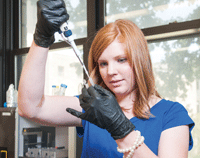A new adhesive composite could improve the long-term postoperative safety of LASIK surgery, according to a recent study in Investigative Ophthalmology & Visual Science.

Stacy Littlechild, a recent graduate in biology, is the lead author of studies that describe a new glue involving fibrinogen, riboflavin and ultraviolet light to improve the safety of LASIK surgery.
Researchers at the University of Kansas have developed a glue mixture of fibrinogen and riboflavin that, when combined with ultraviolet light, could be used to further stabilize the surgically induced corneal flap after LASIK. Sealing the flap with this nontoxic biodegradable composite could help to reduce postsurgical risks and complications, they say.
“Although LASIK produces a flap that remains clear and normally lays smoothly on the modified corneal surface, if the eye is hit with blunt force trauma—from an auto airbag or a tennis ball, for example—the flap simply peels open again, resulting in contamination inside the cornea and requiring immediate medical attention, which can include corneal transplantation,” says principal investigator, Gary Conrad, Ph.D., distinguished professor of biology at the University of Kansas.
To test the glue, Dr. Conrad and associates measured its adhesive strength on experimental flaps that were cut into the corneas of dogfish sharks and rabbits. Then the researchers exposed the corneas to UV light to further bind the composite and seal the corneal flap in place.
“The idea is that if you use the glue, you’ll either reduce or alleviate the risk associated with LASIK surgery,” says lead author Stacy Littlechild. “If we can decrease the need for [corneal] transplants by using a glue, then we won’t impede lives as much and protect patients from having future surgeries.”
Littlechild SL, Brummer G, Zhang Y, Conrad GW. Fibrinogen, riboflavin, and UVA to immobilize a corneal flap—conditions for tissue adhesion. Invest Ophthalmol Vis Sci. 2012 Jun 26;53(7):4011-20.
Ocriplasmin to Treat Vitreomacular Adhesion
Results from two Phase III studies found
that the investigational eye treatment ocriplasmin (ThromboGenics/Alcon)
significantly resolved vitreomacular traction and closed macular holes
in patients with vitreomacular adhesion (VMA). This comes on the heels
of the FDA’s Dermatologic and Ophthalmic Drugs Advisory Committee
recommendation that the FDA grant ocriplasmin approval for treatment of
symptomatic VMA. If approved, ocriplasmin would be the first
pharmaceutical therapy to treat patients with VMA.

